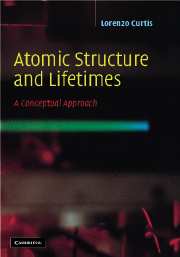Book contents
- Frontmatter
- Contents
- Preface
- List of physical constants and useful interrelations
- 1 Introduction
- 2 Semiclassical conceptual models
- 3 Semiempirical parametrization of energy-level data
- 4 The vector model of angular momentum
- 5 The intermediate coupling model
- 6 Electric dipole radiation
- 7 Line strengths in two-valence-electron systems
- 8 Magnetic dipole transitions
- 9 Absorption of radiation
- 10 Time-resolved measurements
- 11 Hyperfine structure
- 12 Electrostatic polarizabilities and long-range interactions
- 13 Coherence and anisotropic excitation
- References
- Index
6 - Electric dipole radiation
Published online by Cambridge University Press: 06 July 2010
- Frontmatter
- Contents
- Preface
- List of physical constants and useful interrelations
- 1 Introduction
- 2 Semiclassical conceptual models
- 3 Semiempirical parametrization of energy-level data
- 4 The vector model of angular momentum
- 5 The intermediate coupling model
- 6 Electric dipole radiation
- 7 Line strengths in two-valence-electron systems
- 8 Magnetic dipole transitions
- 9 Absorption of radiation
- 10 Time-resolved measurements
- 11 Hyperfine structure
- 12 Electrostatic polarizabilities and long-range interactions
- 13 Coherence and anisotropic excitation
- References
- Index
Summary
Lux aeterna luceat eis.
Let there be light. Take the rest of the week off.
Atomic energy levels deduced from optical spectra comprise one of the most precisely known sets of physical measurements that exist. However, the precision of the determinations of the relative oscillator strengths of these spectral lines from the relative intensities of spectral lines is much less precise. Fortunately, time-dependent methods for the study of the dynamics of the emission process exist (and are being developed) that permit the transition probability rates, oscillator strengths, and reaction rates to be determined with ever-increasing precision.
In most elementary quantum mechanics textbooks, the section on the emission of radiation is the least satisfactory section of the book. Whereas the development of relationships among various spatial overlap integrals between state vectors for various operators (such as the electrostatic dipole moment) can be formulated in a very elegant ab initio manner, the connection of these matrix elements to the time dependence of the system often seems driven by a posteriori assumptions that are extended beyond their justifiable range of applicability. As Fermi observed in stating his Golden Rule, “the transition probability and energy perturbation can be calculated with the help of perturbation theory (i.e., there is no better way known).” The Weisskopf–Wigner approximation offers a scheme for making precise calculations, but does not provide the rigor that has characterized so many other areas of quantum mechanics.
- Type
- Chapter
- Information
- Atomic Structure and LifetimesA Conceptual Approach, pp. 113 - 137Publisher: Cambridge University PressPrint publication year: 2003
- 1
- Cited by



